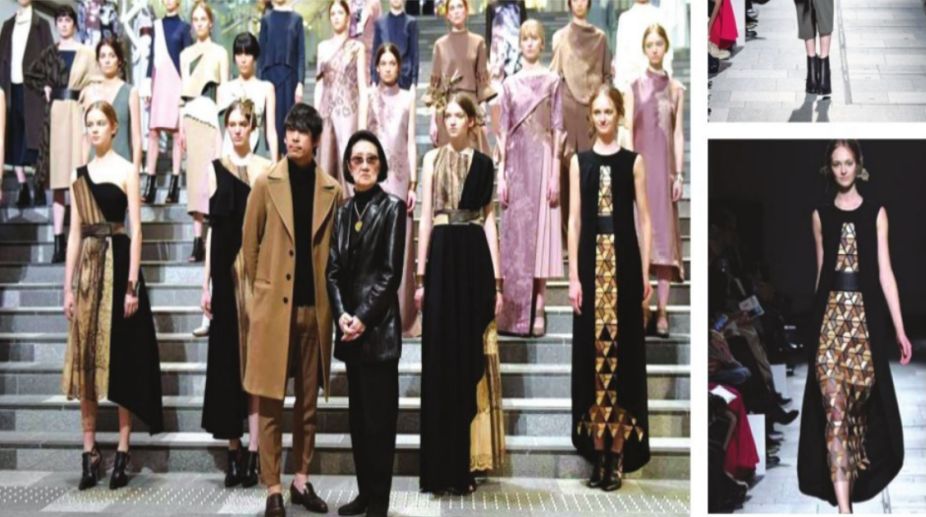Creative use of time
Hobby is a regular activity done for enjoyment during leisure time irrespective of seasons. Nonetheless, few interests suit a particular…

Japanese designers Yu Amatsu (centre, left) and Hanae Mori (centre, right) (PHOTO: SNS)
Wood fashioned into lace and sculpted into evening dresses — the Hanae Mori Manuscrit label led the way this Tokyo Fashion Week in showing the world the original craftmanship that helps set Japan apart from the crowd. Dresses of persimmon wood lace paired with soft falling black fabric were the star of the show at designer Yu Amatsu’s autumn/winter 2017 collection for the brand that left fashionistas giddy with excitement.
Discs of chestnut and walnut were used on a dress of interlocking triangular panels, homage to Issey Miyake’s iconic Bao Bao bag, while wood was fashioned into sleeve ties and delicate butterfly hair pieces. Japan is famous for high-tech and specialty fabrics, which not only supply the likes of Chanel and other celebrated couture houses, but also provide constantly shifting inspiration for homegrown designers.
Advertisement
Misha Janette, a Tokyo-based stylist, creative director and blogger who has lived in Japan since 2004, said Japanese fashion was often less about entertainment and more thoughtful with “amazing” material. “They’re really, really keen on working with young designers to create new fabrics… that sets them apart,” she told AFP. Each little village has its own special kind of fabric. Amatsu said the theme of his collection was “combine”— combining fabrics to create something that was both different and more beautiful.
Advertisement
The persimmon was originally very hard. “Even the sewing machine needle couldn’t go through it. It’s quite heavy so when you move with the dress it makes a 3-D silhouette,” he explained. So he striped it down to 0.14 millimetres wide and bonded it with fabric to make it stronger. He then stitched it into a lace butterfly pattern.
Throughout he was careful to preserve the colour of the wood, making it look almost like pencil shavings or delicately processed tree bark, and there were belts and statement bags in the same material. Inspiration comes from the world at large. “I’m always looking around to find something interesting which can be key for new designs, like the movies, music, architecture and so on,” Amatsu. But wood was far from the only innovative fabric on the runway this Tokyo Fashion Week, which showcased the work of 52 designers.
Husband-and-wife label ROGGYKEI, known best for dressing US superstar Lady Gaga a handful of times, bases itself in Japan’s second city of Osaka to be close to specialist fabric factories. The pair have no plans to relocate, recognising their “made in Japan” heritage was a big boon when they exhibited in Paris in 2012. The fabric is 50 per cent polyester, 50 per cent wool, which designers Hitoshi and Keiko Korogi said makes it more supple. They also use some processed fabrics which they dye and wash. There was a stole made out of a special cashmere woven from Mongolian yarn in Japan’s Nara and coated to make it washable and yet prevent pilling. They presented tiedyed and indigo-dyed stoles too.
ROGGYKEI also used discarded pieces of cloth that would otherwise have been thrown out, and mixed natural materials and chemical fibre. But at least one Japanese designer with an emphasis on cutting edge fabrics admitted to shopping elsewhere. Takuya Morikawa offered a high-energy, Americana-inspired collection of silk dresses, fur and a maroon velvet jumpsuit for label TAAKK, which he set up in 2012 after working for Issey Miyake.
“All the fabrics are originals,” he told reporters. “The jacquards were made in Japan, but I had the embroidery made in China and India as it would have cost a lot to do in such good quality here. Of course Japan has good technique, but I am not too hung up on it. I’d rather use good things from everywhere in the world.”
The Straits Times/ANN
Advertisement